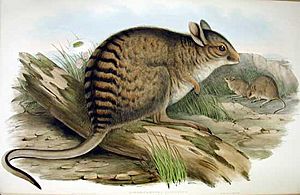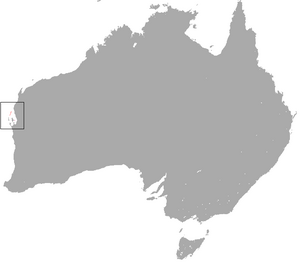Banded hare-wallaby facts for kids
Quick facts for kids Banded hare-wallaby |
|
|---|---|
 |
|
| Conservation status | |
| Scientific classification | |
| Subspecies | |
|
|
 |
|
| Banded hare-wallaby range (red — native, pink — reintroduced) |
The banded hare-wallaby, also known as the mernine or munning, is a small marsupial that lives in Australia. Today, you can mostly find them on Bernier and Dorre off the coast of Western Australia. Some groups have also been moved to other islands and safe fenced areas on the mainland. These places include Faure Island and Wadderin Sanctuary.
Contents
Discovering the Banded Hare-Wallaby
Scientists first wrote about the banded hare-wallaby in 1807. This happened after a French trip to Australia. Two people, zoologist François Péron and artist Charles Lesueur, found a specimen. They collected it on Bernier Island in 1801. They named this new animal Kangurus faciatus.
For a long time, scientists thought the mernine was the only living member of a group called Sthenurinae. But new studies show it's actually part of a very old family branch. This branch split off from other macropods a long time ago. This means the banded hare-wallaby is quite unique! Scientists have even created a new group for it, called Lagostrophinae.
What Does It Look Like?
The average banded hare-wallaby weighs about 1.7 kilograms (around 3.7 pounds). Females are usually a bit heavier than males. From its head to the tip of its tail, it measures about 80 centimeters (31 inches). Its tail is almost as long as its body, averaging 37.5 centimeters (14.7 inches).
It has a short nose and long, grey fur. This fur has yellow and silver speckles. Its belly is a lighter grey. Its face and head are solid grey, with no color changes. Dark, horizontal stripes run across its back. These stripes start in the middle of its back and go down to the base of its tail.
How Does It Behave?
The banded hare-wallaby is a nocturnal animal. This means it is active mostly at night. These wallabies often live in groups at their nesting spots. They are quite social animals. They build their nests in thick, dense bushes. This macropod prefers to live in Acacia ligulata scrub areas. Male banded hare-wallabies can be very aggressive, especially towards other males.
Where Do They Live?
The banded hare-wallaby used to live on the mainland of Australia. You could find them in the southwest of Western Australia and South Australia. But now, the only natural groups left are on Bernier Island and Dorre Island. These islands are off the coast of Western Australia.
However, people have successfully moved them to new safe places. These include Faure Island and Dirk Hartog Island in Shark Bay. They also live in a large fenced area at Mount Gibson Sanctuary in Western Australia.
Scientists believe the banded hare-wallaby disappeared from the mainland by 1963. The last time one was seen on the mainland was in 1906. Their disappearance was likely due to losing their homes. This happened when land was cleared. They also faced less food because of other animals. Plus, predators hunted them.
Types of Banded Hare-Wallabies
There are two recognized types, or subspecies, of the banded hare-wallaby. These are L. f. fasciatus and L. f. baudinettei.
What Do They Eat?
This diprotodontian animal is a vegetarian. This means it only eats plants. It gets most of the water it needs from its food. It likes to eat different kinds of grasses, fruits, and other plants. Male aggression is usually about competing for food with other males. They are rarely aggressive towards females.
How Do They Reproduce?
The mating season for banded hare-wallabies starts in December and ends in September. They become old enough to have babies at one year old. However, they usually start breeding in their second year.
Pregnancy seems to last for several months. Mothers usually have one baby each year. But some females can have two young in a year. The young stay in their mother's pouch for six months. They continue to drink milk for another three months after leaving the pouch. If a mother's baby dies, she might have an extra embryo ready. This allows her to possibly raise another young one.
See also
 In Spanish: Ualabí liebre de bandas para niños
In Spanish: Ualabí liebre de bandas para niños



